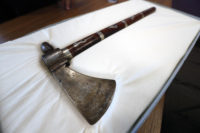 The pipe tomahawk given by George Washington as a diplomatic gift to Seneca chief Cornplanter in 1792, has been on loan to the Seneca Nation since March of last year. It was in the collection of the New York State Museum in Albany since 1851 when it was donated by Seneca statesman, US Army lieutant colonel, aide to Ulysses S. Grant during the Civil War and the first Native American Commissioner of Indian Affairs Ely Samuel Parker, only to disappear under circumstances never explained sometime between 1947 and 1950.
The pipe tomahawk given by George Washington as a diplomatic gift to Seneca chief Cornplanter in 1792, has been on loan to the Seneca Nation since March of last year. It was in the collection of the New York State Museum in Albany since 1851 when it was donated by Seneca statesman, US Army lieutant colonel, aide to Ulysses S. Grant during the Civil War and the first Native American Commissioner of Indian Affairs Ely Samuel Parker, only to disappear under circumstances never explained sometime between 1947 and 1950.
It spent the next seven decades being sold by private collectors to other private collectors on the black market. The last one of them, a woman in the Northwest, bought it for $75,000. In April 2018, she had her lawyers contact the museum to report her acquisition of an artifact that might belong to them. With the law firm acting as intermediary, the unnamed collector offered to return the pipe tomahawk to its legitimate owner. The museum received it in June 2018 and it went on display in the Albany museum’s main lobby on July 17th. The exhibition ran through December 17th.
Disappointed by violated treaties and broken promises, Cornplanter destroyed most of the gifts he had received from the US government. He died in 1836 and there is no record of what happened to the rare surviving pipe tomahawk until Parker’s donation. So when Cornplanter’s pipe tomahawk was loaned to the Seneca-Iroquois National Museum in the Seneca Nation’s Allegany Territory in March 2019, that was the object’s first return to Seneca territory since at least 1851.
 Seneca-Iroquois National Museum chairman Rick Jemison, director David L. George-Shongo Jr. and Seneca Nation president Rickey L. Armstrong Sr. argued that the tomahawk should stay with the Seneca as it is an important and very rare belonging of one of their greatest luminaries as well as material evidence of the earliest connections between the Senecas and the United States government. The New York State Museum was not persuaded at the time. Apparently the collector who had bought the stolen artifact and gave it to the museum stipulated that it must remain part of the museum’s the permanent collection.
Seneca-Iroquois National Museum chairman Rick Jemison, director David L. George-Shongo Jr. and Seneca Nation president Rickey L. Armstrong Sr. argued that the tomahawk should stay with the Seneca as it is an important and very rare belonging of one of their greatest luminaries as well as material evidence of the earliest connections between the Senecas and the United States government. The New York State Museum was not persuaded at the time. Apparently the collector who had bought the stolen artifact and gave it to the museum stipulated that it must remain part of the museum’s the permanent collection.
I’m not sure what kind of legal force that requirement could have given the “donor” had no clear title to the tomahawk. Surely the legal owner was the New York State Museum. The donation, it seems to me, was a formality to effectuate the returned of trafficked goods.
Whatever the contractual mechanisms of the donation, they’re moot now. The museum has had a change of perspective since last year and on Thursday, January 9th, the New York State Museum and the Seneca Nation announced that ownership of Cornplanter’s pipe tomahawk has been officially transferred to the Seneca Nation.
“In Seneca history, Cornplanter stands among our greatest and most respected leaders,” said Seneca Nation President Rickey L. Armstrong, Sr. “George Washington originally presented this pipe tomahawk to Cornplanter as a sign of respect, friendship and recognition of our sovereignty. Now, this piece of our great leader’s remarkable legacy can finally – and forever – remain on Seneca land where it belongs.”